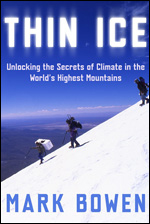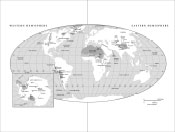

Thin Ice
Henry Holt and Co.
A John Macrae/Holt
Paperbacks Book
496 pages
Size: 5.5" x 8.5"
Two 8-page b&w inserts
$17.00
Paperback
Pub Date: 10/3/06
ISBN: 0805081356
Improved Map:
Owing to a mix-up during
production, an early, working
draft of the world map
appears in the first printing
of Thin Ice, in which a few
locations in Asia and
Antarctica are misplaced.
This error was rectified in the
paperback edition.
To view, download, or print
the correct map,
click the image:

Surprisingly, since the book was originally published in 2005, Gavin Schmidt at RealClimate selected Thin Ice as one of the more interesting books to have crossed his desk in 2007. Gratifying as well, since it indicates that the book remains relevant to a team of people who truly understand climate science and the global warming issue:
RealClimate.org
Thin Ice by Mark Bowen gets a big thumbs up as well. It is more or less a biography of Lonnie Thompson, but as I said in my review in BAMS, it is by no means limited to Thompson’s work. Much of the book focuses on various important figures in the history of the science of climate: Arrhenius, Tyndall, and Keeling among them. And while paleoclimatology takes the main stage, one could read this book alone for a very clear lay-persons understanding of the physics of the greenhouse effect, or for insight into the mind of the brilliant and provocative James Hansen, or the story or Roger Revelle and David Keeling's measurements of carbon dioxide concentrations. It is notable that Bowen has a PhD from MIT, so is no newcomer to science.
– RealClimate.org
Praise for Thin Ice
Named Best Science Book of 2005 by National Public Radio's weekly environmental program, Living On Earth.
“One of the best books yet published on climate change.”
Bill McKibben, author of The End of Nature, writing in the "New York Review of Books," January 12, 2006
"Capturing the fanatical enduring love of a scientist for his work, wars and pettiness amongst terrestrial 'big-thinkers,' and heroic failures and success in the most forbidding and spectacular places on our planet, Thin Ice is more revealing than The Double Helix."
Dr. James E. Hansen, Director, NASA Goddard Institute for Space Studies
"Superheroes, unconquerable courage and towering intellect at deadly altitudes; it would be a great bigger-than-life novel--if it wasn't all true. A thrilling scientific adventure, Thin Ice just happens to be about an issue that stands poised to change the course of human history."
Carl Safina, author of Eye of the Albatross and Song for the Blue Ocean
Reviews of Thin Ice

Real Climate.org
Nature (complete article in pdf format)
Scientific American
Publishers Weekly
Kirkus
Booklist
Library Journal
Nature
“The closest living thing to Indiana Jones, and just in time.” That’s how Harvard geochemist Daniel Schrag described Lonnie Thompson, the pioneer of high-altitude ice-core drilling of tropical and subtropical glaciers.
In Thin Ice, Mark Bowen, a physicist and passionate mountain-climber, describes the numerous expeditions that Thompson and his colleagues organized — from the Andean Altiplano to Tibetan ice sheets, from the Alaskan Bona-Churchill glacier to Mount Kilimanjaro in Kenya [sic].
Bowen adds a political dimension to the scientific narrative, arguing strongly for the promotion of climate change to the ranks of the world’s most pressing problems. The assertion is justified by the race against time for researchers such as Thompson who are trying to extract information about past and present climate shifts from the world’s disappearing glaciers. Had Thompson started his work today, many of the frozen archives he used would not have been considered as potentially rewarding drilling sites — the quality of many signals in the ice has already been degraded by recent warming.
Bowen, who accompanied Thompson on two of his expeditions, tells this story in an amusing and entertaining style. The book often changes its focus, switching from thrilling mountaineering anecdotes to interviews with different scientists and historical retrospectives of Earth science. Often Bowen delivers fine pieces of science journalism, describing for example Charles Keeling’s first measurements of carbon dioxide in the 1950s on Mauna Loa, Hawaii. Thin Ice is at the same time a scientific biography, a fine introduction to the sciences of climate change, and a vivid description of a geophysicist’s work under most extreme conditions.
© 2006 Nature Publishing Group
Scientific American
The idea of drilling ice in the tropics as a means of studying changes in climate over thousands of years seems implausible. That work is usually done in polar ice. But Lonnie Thompson, professor of geological sciences at Ohio State University, has taken ice cores from glaciers on many high mountains in the tropics and found that they add fruitfully to the history of climate change. His reasoning was that climate arises from flows of energy from the sun and that most of that energy enters the atmosphere through the tropics.
Bowen, a science writer and mountain climber with a doctorate in physics, accompanied Thompson on several expeditions. In a smoothly flowing narrative, he describes drilling ice at high altitudes and explains the science that points to a steady rise in global temperature as a result of human activities. That science prompted the Intergovernmental Panel on Climate Change to declare in 2001 that there “is new and stronger evidence that most of the warming observed over the last 50 years is attributable to human activities.”
“A change of nine or ten degrees would almost certainly cause widespread catastrophe,” Bowen writes in summarizing the panel’s predictions. “Available freshwater would plummet, taking crop yields along with it.... Increased flooding would pose a deadly risk to tens of millions of residents of low-lying areas.” But, Bowen says, doing anything effective to curb the trend will be difficult: “The economic interests who fear any sensible discussion of global warming have succeeded in politicizing this branch of science more perhaps than any other.”
© 2006 Scientific American
Publishers Weekly
(This appeared more than a month before Hurricanes Katrina and Rita.)
Residents of Florida and the Gulf Coast have seen an unusually early hurricane season this year. Thousands of people die every month as drought continues to grip Africa. In August 2003, 15,000 people, mostly senior citizens, died in a French heat wave. Popular-science author Bowen shows readers how these events result from climate disruption caused by global warming. Bowen frames his story with the exploits of Lonnie Thompson, a professor at Ohio State who pioneered the study of glaciers near the equator. Thompson challenged and eventually changed accepted beliefs on how climate change occurs with his revolutionary lightweight-coring techniques that draw ice cores from glaciers in South America, on the China-Tibet border and elsewhere. Bowen explains how carbon dioxide and water vapor interact to regulate our planet's thermostat and argues that scientific evidence conclusively shows that use of fossil fuels has accelerated global warming; in our lifetimes, he predicts, the snows of Kilimanjaro will be no more. This book will appeal to mountaineering and climatology buffs, but should be read by everyone concerned about the future of our planet.
Copyright © Reed Business Information, a division of Reed Elsevier Inc. All rights reserved.
Kirkus Reviews (Starred review)
Mountain-climbing journalist Bowen accompanies researchers as they dig atop glaciers at the Earth's equator and gives an in-depth report on the field of climatology.
Lonnie Thompson has long been a towering figure in the world of climate science. Once seen as an iconoclast who had a wild idea about studying the ice near the planet's equator, he's now acknowledged to be a visionary in the field. With his dramatic, low-budget, seat-of-the-pants trips to the glaciers of Africa, China and South America, Thompson makes a great character for Bowen to fashion a book around. But while the author starts off trying to weave in hard science with tales of Thompson drilling ice in sub-zero temperatures, transferring core samples in hot-air balloons, this is ultimately a history of the science, covering climatology's beginnings and citing projections for the near future. (Mt. Kilimanjaro won't have its snows much longer, the author notes.) Bowen is deeply concerned about global warming—with the weather patterns that the Earth has seen and will likely experience in the future and the many players large and small who have contributed to the understanding of how humans are changing the planet's atmosphere.
The author intersperses stories of Thompson's treks with discussions of scientific infighting, congressional debates, struggles for funding, the health and history of the Earth's atmosphere and on and on. The work's structure bears a passing resemblance to Moby-Dick, part adventure tale, part densely annotated guide to Thompson's profession. Bowen covers an enormous amount of ground in impressive, accessible detail. For those interested in global warming, the hard facts, backed by prodigious amount of investigation, will be most welcome.
A tremendous work of research, with plenty of entertaining adventure and colorful characters to boot.
© (2005) Kirkus/ VNU eMedia, Inc. All rights reserved
Booklist
Bowen is a science writer and climber. Lonnie Thompson is a climatologist from Ohio State University who spends much of his time studying remote ice caps along the equator to map the course of climate change. Bowen first joined Thompson on the summit of Nevado Sajama, the highest mountain in Bolivia. Sajama--21,500 feet high--is in what climbers call the "death zone," the environment above 18,000 feet. Bowen also joined Thompson for three weeks on Tanzania's Kilimanjaro, the highest mountain in Africa. The 19,344-foot Kibo is the highest of three volcanoes there. Bowen describes the pain brought on by climbing at that height, the equipment, the warm clothes and boots required to survive months in harsh conditions, and the equipment needed to perform research involved in ice core climatology. Bowen offers a detailed background of the science of climatology and Thompson's part in this scientific pursuit to comprehend the global climate system. Readers will be intrigued by the author's exceptional narrative and--at the same time--will able to stay safe and warm.
George Cohen
Copyright © American Library Association. All rights reserved
Library Journal (Starred review)
Bowen was contacted by a magazine editor looking for a science writer with climbing experience to join paleoclimatologist Lonnie Thompson on his expedition to drill ice cores on the summit of Bolivia's highest mountain. Retrieving ice cores, which are read like tree rings and present detailed information about climate history, requires that climatologists spend weeks, even months, working in the "death zone," the area above 18,000 feet. Here Bowen, who accompanied Thompson on several more expeditions, documents the specialized techniques that Thompson used to extract and preserve ice cores from the highest mountains around the world's equator while also examining Thompson's research, which is based on the provocative premise that equatorial mountain glaciers, rather than polar ice, provide the clues to understanding global warming. Bowen chronicles the global warming debate from its earliest predictors up to the present and notes the undeniable fact that temperatures have noticeably risen over the past 50 years, with the high latitudes experiencing the fastest warming. Bowen and Thompson believe that the snows of Kilimanjaro will disappear within the next 15 years, evidenced by its already retreating glaciers. Both a gripping adventure tale that will appeal to armchair mountaineers and a serious science account, this timely book is highly recommended for all academic and larger public libraries.
Gloria Maxwell, Penn Valley Community Coll. Lib., Kansas City, MO
© Reed Business Information, a division of Reed Elsevier Inc. All rights reserved.
Also reviewed in Mother Jones, Men’s Journal, Entertainment Weekly, Science News, Backcountry, the Washington Post, and other publications.
ORDER
Thin Ice
AT THESE LINKS:
![]()
Amazon.com
